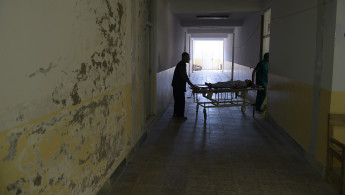Creaking Afghan hospital symbol of foreign aid failure
After fifteen years and tens of billions of dollars in foreign aid, Afghanistan is still dangerously unstable and persistently at the bottom of almost every major human development index.
Its perpetual state of need is a growing impediment to those trying to encourage donors to keep on giving, and will hang over a crucial development aid conference in Brussels this week.
The $600,000 hospital, funded by US forces in Afghanistan under a programme to create Afghan jobs, was meant to be a modern 20-bed facility replete with dental, paediatric and surgical wards in the mountainous, poverty-stricken area of Salang near Kabul.
Instead, it is a decrepit, structurally deficient building in an earthquake-prone region, which is underused, understaffed and poorly equipped.
It stands as an illustration of how the West splurged on institutions that Afghanistan cannot afford to run or maintain.
"How are we supposed to treat patients? With tables and chairs?" asked the surgeon Qutbuddin Shams, who must bend to perform surgery because the foot pedal that adjusts the height of the operating table is broken.
Whirring generators offer a fitful supply of electricity, essential anaesthetic equipment is in short supply, and puddles of water and blood have to be manually swabbed in the absence of a proper drainage system.
In a corner of the operating room is something it does not need – a flush toilet.
"This is like a regular house converted into a hospital. Those who built it don't understand the requirements of a hospital," Shams told AFP.
 |
Whirring generators offer a fitful supply of electricity, essential anaesthetic equipment is in short supply, and puddles of water and blood have to be manually swabbed in the absence of a proper drainage system |  |
An inspection by the watchdog agency SIGAR found the Afghan contractor who built the hospital was paid in full despite the glaring deficiencies.
Newborn babies are washed with untreated water and patients suffer freezing temperatures in winter because the heaters do not work.
The dental ward, where tooth extractions were carried out with pliers in the absence of equipment, recently shut down over fears the tools had become badly infected.
 |
Newborn babies are washed with untreated water and patients suffer freezing temperatures in winter because the heaters do not work |  |
The hospital is not an anomaly. It is among a series of what observers call "pie in the sky" projects that serve as a cautionary tale of how too much aid money with too little oversight can spell catastrophe in a country roiled by graft.
"Corruption is an existential threat to the mission in Afghanistan," said Jodi Vittori, policy adviser at international campaign group Global Witness.
Donors never put in place basic protections to ensure accountability, even as money pilfered from aid "flowed to predatory elites in the country", she continued.
"That's a massive strategic blind spot that has jeopardised the blood and treasure invested there since 2001."
The United States has spent around $110 billion on Afghanistan's reconstruction since 2001, more than the cost of the Marshall Plan that rebuilt a devastated Europe after World War II.
Reconstruction in one of the poorest, most violent and corrupt nations on Earth can be akin to building on sand.
Many of the schools, clinics and warehouses built by USAID and other development agencies lie vacant, unused or are just shells of concrete and steel bars, SIGAR says.
The US constructed fragile roads to American weight standards – without factoring in notoriously overweight Afghan trucks – and spent millions on airplanes that were unfit for use.
 |
Corruption is an existential threat to the mission in Afghanistan |  |
Donor quandary
Some projects were culturally tone deaf, such as a $34 million programme to push Afghan farmers to produce soybeans – a crop that does not grow well in the country and which Afghans are generally averse to consuming.
And perhaps the biggest failure of the reconstruction effort is the $8.4 billion counter-narcotics programmes that have been so ineffective that Afghanistan now produces significantly more opium than it did before the 2001 US-led invasion.
The opium trade is estimated to be worth around $3 billion a year and is a key source of income for the Taliban.
Worse still, experts say Western assistance has helped exacerbate the very problem that aid agencies were trying to solve – chronic dependence on aid.
 |
Experts say Western assistance has helped exacerbate the very problem that aid agencies were trying to solve – chronic dependence on aid |  |
At the Brussels conference on Afghanistan, co-hosted by the European Union, the country is seeking to attract annual pledges of around $3 billion until 2020.
Donor nations are caught in a quandary, observers say. Without continued high levels of international assistance, despite past failures, there are fears that the government could collapse and Afghanistan could once again become a haven for insurgent groups.
Back in the Salang hospital, there are more immediate concerns as doctors receive a man on a stretcher who had fallen from a tall walnut tree, possibly causing serious damage to his spine.
"Allah!" he screeched, writhing in agony as hospital staff swarmed around him. One cleaned the blood stains on his face, another scrambled to cobble together a rudimentary splint with cardboard and wads of cotton.
Ashen-faced, hospital administrator Lal Mohammad Salangi walked out of the scrum.
"We don't have what it takes to treat his injury," Salangi said. "After basic first aid we will have to send him to another hospital."


![President Pezeshkian has denounced Israel's attacks on Lebanon [Getty]](/sites/default/files/styles/image_684x385/public/2173482924.jpeg?h=a5f2f23a&itok=q3evVtko)



 Follow the Middle East's top stories in English at The New Arab on Google News
Follow the Middle East's top stories in English at The New Arab on Google News


